Official invitations. Event invitation: text, design
Business correspondence often appears between companies or different offices of the same company. In the letter, you can always provide information on the order, clarify the details, invite you to a meeting. In this material, we will figure out how to properly arrange invitation letter, a sample of which you can download at the bottom of the material in word format.
Invitation letter- an official letter that is sent to the addressee on the occasion of an event, conference, meeting. An invitation letter can be issued in order to invite a person to an interview, meeting. Many companies use the verbal form of transferring textual information, and the letter of invitation appears as additional remedy pay attention to the addressee.
As an official document, an invitation letter has a number of advantages, let's consider them all in order.
- Thanks to such a letter, you can show respect for the addressee.
- The presence of such a letter indicates that the recipient is indeed invited to the event and should arrive on time.
- Such a letter can be sent to the addressee if it is not possible to contact him in any other way.
- The invitation letter will always be in front of the recipient's eyes, and he will not forget about the upcoming meeting, for example, if he was invited to participate as a speaker at official event.
You can send such an invitation letter using the services of the Russian post or e-mail.
We also offer you to download sample requests-reminders, confirmations, requests.
How to write an invitation letter for an interview, meeting or meeting?
Any official event involves active and passive participants who must be invited in advance by sending them an invitation letter. Having such a letter in hand, the participants of the conference, seminars, meetings or meetings will be able to prepare and rationally plan their time.
such a document is drawn up on the letterhead of the enterprise with contact details and details. In the upper corner of the letter, the addressee's personal data is indicated, if necessary, the name of the enterprise or company.
An appeal to the addressee is written in the center, then the essence of the letter is stated in a free style. Be sure to mention the event to which you invite the addressee. It can be a meeting or an interview, a meeting or a meeting, a conference or a tasting, etc. Be sure to indicate the name of the event and attach the program, if any.
The following is the date of the event and the exact time. The location of the event is indicated in detail. In addition to the address, you must specify the exact number of the house, office, floor, and even the location map, ways in which you can get to the meeting point. In particularly difficult cases, a plan of the building in which the company's office is located is required.
You can complete the letter of invitation with gratitude to the addressee for the attentiveness to the letter and its contents, for taking the time to study the enclosed materials. The author signs the letter, if necessary, a seal is put.
Having such an invitation, the addressee can respond to it, confirm their participation in the event or refuse, presenting reasonable arguments.
Download invitation letter. Sample Fill
Instruction
Choose the optimal treatment. It should correspond to the image of the addressee and the level of your communication with him. At present, the Russian language uses the appeals " mr" (in abbreviation mr), "madam" (mrs), "gentlemen". The official wording: "Dear Mr...." always accompanies the surname. You can address by name and patronymic, then the form "mister" is omitted. For example: "Dear Pyotr Semenovich."
Formulate the main phrase (or text) of the official invitation. Here you must specify who invites, why and where. The wording must be strict, literary, grammatically and orthographically correct. Usually complex sentences with participial phrases are formulated, the full and official name of the institution and organizers is used. For example: "Siberian State Industrial University invites ...". The invitation uses speech clichés:
We invite you (you) to / take part in ...
We have the honor to invite you...
We are sending you an invitation to...
Allow/let me invite you to…
We are pleased to invite you….
Indicate further what event is planned, for what purpose or what is dedicated to. For example: "...to take part in the presentation of the results of the development of the master plan for the reconstruction...", "...for a banquet / celebration on the occasion of...", "...for celebrations dedicated to...". Specify where, when and at what time the event will take place. This information can also be given in a separate sentence if the previous one turned out to be very large.
Write, if required, where invitation cards are obtained or purchased. And also, if it is important, place a request to confirm the acceptance of the invitation or participation. Use the phrase “Please confirm your consent/participation/your arrival…” and indicate how it is best for the invitee to do this - by letter, by fax or by phone. End the invitation with the standard wording “Sincerely, ...”, indicate the last name, first name and, possibly, position.
The participle is a verb form that has the properties of a verb and an adjective. Participle with dependent words forms participle turnover. It can often be confused with a verbal adjective. How to identify an accomplice turnover and how not to confuse it with other parts of speech?
Instruction
First of all, identify the participles in the active voice. Suffixes will help you do this, with the help of which participles are formed from verbs: -usch-, -yushch-, -ash-, -yash-. For example, walking, thinking, lying, smoking. To form past participles, the suffixes -vsh-, -sh- are used. For example, thought, expired. With participles in the passive voice, it’s not so easy to figure it out, because. they are formed using the suffixes -em-, -im- (readable, persecuted), -en(n)-, -n(n)-, -t- (entrusted, removed, locked). Do not confuse them with verbal adjectives, because the participle also agrees with the noun, has gender, number and case. For example, "tired and exhausted, he was taken home."
Consider the distinctive verbal features of the participle in more detail. The sacrament, like the verb, can be perfect and imperfect (bathed and bathed). It can be active or passive (“the writer who wrote the book” and “the book written by the writer”). For real participles it is possible to define transitivity. For example, doing is a transitive participle, and walking is an intransitive participle. The participle has such a feature of the verb as reflexivity (walking is an irrevocable participle, and walking is a recurrent participle), and can also be in the present and past tenses (“the student who completed the task” and “the student who completed the task”).
So, if you have a part of speech denoting a sign of an object, determine the nature of this sign. A verbal adjective denotes a constant attribute of an object. The participle, on the other hand, denotes a temporary sign of an object associated with its participation in an action. Examples. Brought up in strict rules She never allowed herself such antics. "Brought up in strict rules" - communicant turnover, because can be replaced by “she was brought up in strict rules.” The girl was well-mannered, educated and well-read. "Brought up, educated and well-read" - adjectives. Designate a permanent attribute of an object.
If the word has the suffixes -n- (-nn-) and -en- (-enn-), determine what kind of verb it is formed from. If
- Samples of powers of attorney and commercial offers
- Automatic filling of standard forms of documents
- Printing Documents with Signature and Seal Image
- Letterhead with your logo and details
- Uploading documents in Excel, PDF, CSV formats
- Sending documents by email directly from the system
Class365 - fast and convenient filling of all primary documents
Connect for free to Klass365
The letter of invitation is special case notification letter, which is used to invite to some event (exhibition, negotiations, meetings, seminars, etc.)
It differs in that the letter of invitation can be issued not on letterhead and have artistic decorations: drawings, ornaments, and so on.
How to simplify paperwork and record keeping with ease and ease
See how Class365 works
Login to demo
How to write an invitation letter
As in other official letters, it is customary to use the first-person plural in an invitation letter: “we invite”, “we ask”, etc. (because the author of the letter speaks on behalf of the entire organization or unit).
Usually (but not always) an invitation letter is addressed personally to a specific person, therefore the wording of a personal appeal is used: “Dear (th, th) ...,”.
Stereotypical expressions are also used:
“We invite you, we have the honor to invite you, take part, visit, etc.”
“We will be grateful, grateful, obliged to you if you visit us as (experts, guests, etc.) ..., etc.”
Like other types of official letters, an invitation letter is drawn up according to a template:
[Address]
[phone, email, etc.]
Dear (th, th) ladies and gentlemen.
We invite you to participate in [name and/or description of the event], which will take place at [address/name of institution, etc.].
Organizers of [event name]: [list of organizers].
Presenters of [event name]: [list of presenters].
During [event name]: [what is it about, a list of issues discussed, and so on].
[Some additional information]
Behind additional information o [event name] contact [telephone, email, address, etc.].
The General Director of such and such an office signature V.M. Batkovich
Mandatory details of the invitation letter: name of the organization, organization code, reference data about the organization, PSRN, TIN, date, registration number, addressee, signature of the head, note about the performer.
The text of the letter of invitation should be short, concise, correct and should not allow different interpretations. An invitation letter should be devoted to only one issue (event, event), except for cases of their close relationship and location in the same structural unit of the sending organization. The letter is drawn up in two copies (the second copy is endorsed by the compiler, the head of the sending unit and remains with the sending organization).
Get started with Class365 right now! Use a modern approach to business management and increase your income.
Connect for free to Klass365
Any scheduled event that requires the presence of unauthorized persons (not employees of the company) implies the prior sending of letters of invitation. At the same time, the differences between the events themselves are also displayed on the text of invitations. In this article, we will look at how to make an official invitation to any meeting or negotiations.
In this article, we'll look at:
- official letter of invitation;
- letter of invitation to a meeting;
- letter of invitation to negotiations.
Official Letter of Invitation
Organization and preparation of any event (at which the presence of visitors is planned) is carried out taking into account the creation and distribution of letters of invitation. This is especially true for events for which lists of guests are compiled, whose presence is welcome.
In this case, it will not be enough just to call them and tell them about the upcoming event. It is important that the invited person is aware of the scale of the event and own significance. It is for this that we will consider how to correctly compose an invitation letter (a sample is presented below).
Invitation letter (sample)
The formal letter of invitation is a variation. Belonging to this category is determined based on the purpose of the invitation: to notify the right people about the upcoming event, time and place of its holding. This letter is different in that it is sent in a single copy personally to each invitee. Simply put, each letter of invitation is personalized.
Moreover, it may contain information relating to each invitee individually (for example, seat number, row, etc.).
Features of the design of the invitation letter are associated with the lack of a standard design of letters. As a rule, the invitation has more than presentable appearance than a simple business letter. It is often used to design good paper(not a standard office one), various decorative elements and more. In this case, the invitation can be handwritten in beautiful calligraphic handwriting. In general, as you already understood, this letter can have almost any color and look.
Note that in this case standard forms are very rarely used for registration business letter. However, if you want to write an official letter of invitation to a business event, then its execution using the letterhead is acceptable.
letter of invitation to a foreigner
When sending an invitation letter to foreign citizens, you must take into account that they may not know your city at all. In this case great solution will be an attachment to the letter of accompanying documents, which are a map of directions to the venue, your organization, etc.
Also in this case, it is necessary to take care of settling a foreigner in a hotel for the duration of his stay. If the host party pays for accommodation, flights, transfers and other services, then this should also be mentioned in the documents accompanying the invitation.
A foreign guest should understand that attending this event will not be a problem for him, but will be a pleasant journey. Moreover, the level of preparation for the arrival of a foreign guest will significantly reduce the possibility of a possible refusal.
Business invitation letter (sample)
![]()
When drafting it is necessary to take into account national characteristics. In this case, you should not write an invitation to mother tongue invited: it will be enough to compose it on English language. Believe me, an invitation in English will create more pleasant impression than Japanese, but with more errors.
An invitation for foreigners to an event should be sent much earlier than for other participants. When planning events with the presence of foreign citizens, consider how long it will take for them to complete the necessary documentation (visas, holidays), flights, etc.
meeting invitation letter
The letter of invitation to the meeting should be addressed directly to the interested parties. IN this letter You should describe in detail the topic of the meeting, the issues that will be considered at it. You should also notify the meeting place and time. At the same time, such an invitation can only be sent to the head of a particular organization.
If necessary, he himself can decide on the need for the presence of other competent employees. However, such an item requires notification in a response letter so that seating for all those present can be planned in advance. Read template official letter invitation to view its design.
Event invitation letter (sample)
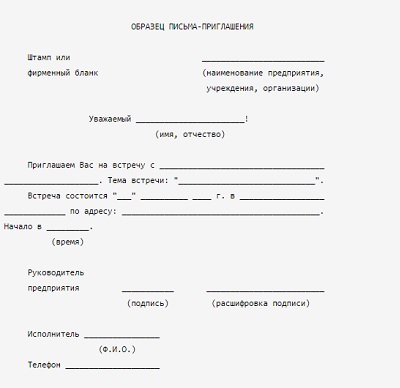
Letter of invitation to negotiations
Before thinking about sending an invitation, it should be borne in mind that there are two types: operational and planned. When preparing an operational meeting (which is held according to a certain schedule), the secretary must deal with inviting participants, notifying the head of those who did not appear and finding out the reasons for the absence. During the operational meeting, the secretary should be in the reception area and receive calls and visitors.
When holding a scheduled meeting (meeting) with a large number of participants, preparation begins 1.5–2 weeks before its holding and includes the following steps:
- appointment of the date, time and place of the meeting;
- drawing up the agenda, list of participants and speakers;
- performing work that may be required before the start of the meeting;
- drafting the text of the invitation.
A special type of negotiation is the so-called " brainstorm". Such an event is held when it is necessary to solve a complex problem, find a way out of confused situation to make a responsible decision.
Letter of invitation to negotiations (sample)
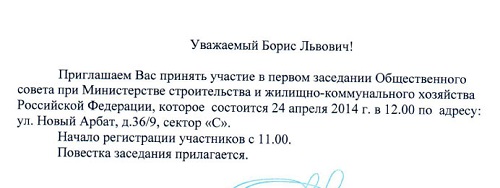
Despite the seeming formality, working with invitations is one of the key points in the preparation of any event. It is the invitation that is the “face” of the hero of the occasion and the entire upcoming event as a whole. How to invite guests correctly and what to consider when preparing the perfect invitation? We will talk about this in the article.
After receiving an invitation, the guest decides whether to participate in the event. If the invitation of the recipient interested or even intrigued, if he became curious about how the program of the event would come to life, or if, looking at the invitation, executed professionally and with taste, he thought about what level of person could be there, then the organizer of the event successfully coped with this task of preparing the celebration!
According to the responses to invitations, it becomes clear what approximate number of guests should be expected. You need to know this in order to make a seating plan for a banquet, order refreshments and drinks, plan seating in the hall during the official part, arrange transfers, book hotel rooms, etc.
Let's take a closer look at the process of preparing an invitation as close to ideal as possible.
WE MAKE A LIST OF GUESTS FOR PREPARING INVITATIONS
To ensure that the process of preparing invitations, sending them out, and receiving responses from guests goes as smoothly as possible, it is necessary to carry out careful preliminary work.
Responsible for it is desirable to appoint a person who freely navigates the list of guests. Ideally, if the organizer of the event does everything himself!
HOW TO MAKE A LIST OF INVITATIONS
1. Think over the list of guests with the head. Go back to the list several times to make sure no one is left out and that none of the guests will be inconvenienced by someone else's presence.
2. Find out how the manager plans to address each guest in the invitation (to some - by name, patronymic, to others - only by name, and to the third - dear sir / madam / Mr / Ms / Madame / Monsieur ... etc. .).
3. Make a list of names for printing in the printing house.
4. Make sure that all the persons listed by the manager are known to you and that you have their contact details.
5. Compile a list of email addresses for sending email invitations.
6. Decide which of the guests will receive an invitation to a personal email and who should send it through the assistant/secretary/receptionist.
7. Compose text cover letter(for those invitations that will be sent to the email of assistants, secretaries or receptionists). An example of such text:
8. It is advisable to use the "Notify me when I received/read a letter" option so as not to disturb potential guests with unnecessary calls asking if they received an invitation.
9. Compile a list of mailing addresses for delivery of invitations to paper form. Distribute in advance which of them will be delivered by courier service, and which ones personally. In the latter case, you need to take care of the passes.
10. Establish feedback with the invitees, that is, decide how you will receive confirmation of the presence from them: wait for answers from the guests or start calling them yourself to find out the decision. In the second case, you need to decide after what period of time it is appropriate to call potential guests. Decide who exactly will do this, since the list can be rather big, and the responsibility for a polite but persistent conversation is even greater.
11. Make sure that the contacts indicated in the invitation for feedback relevant: mail is “working”, the phone is on, calls are answered.
12. Be sure to ask those guests who accepted the invitation whether they need additional organizational support: whether they need to provide a transfer or accommodation in the city of the celebration, whether there are special requests for products at the banquet, taking into account possible food allergies or specific food systems (vegetarianism, e.g.), or perhaps something else.
13. Promptly make changes to the list of invitees.
An example of working with the list of invitees is presented in tables 1-4.
Table 1. List of invitations generated by delivery method

Table 2. List of addresses (names) for printing in a printing house
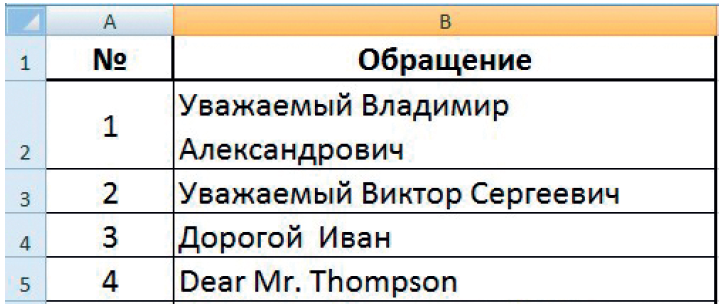
Note:
The serial numbers correspond to the delivery list numbers.
Table 3 List of guests who accepted the invitation, indicating the necessary organizational support

Table 4 List of guests who declined invitations
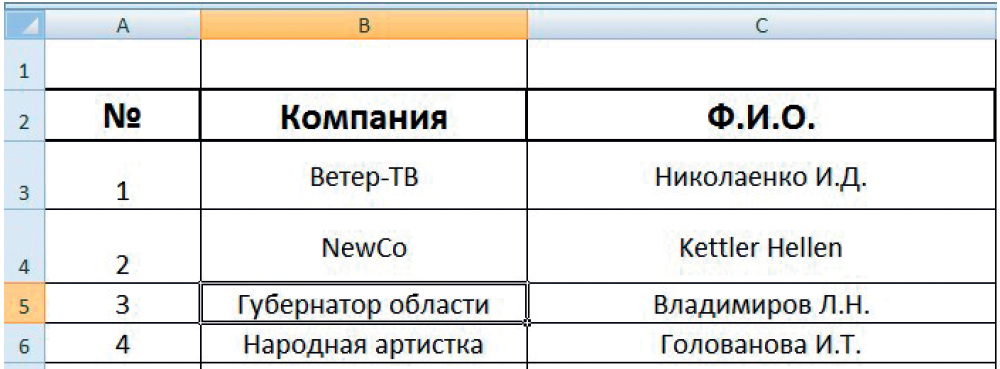
WRITING THE TEXT OF THE INVITATION
Let's take a closer look at the main elements of the text of the invitation.
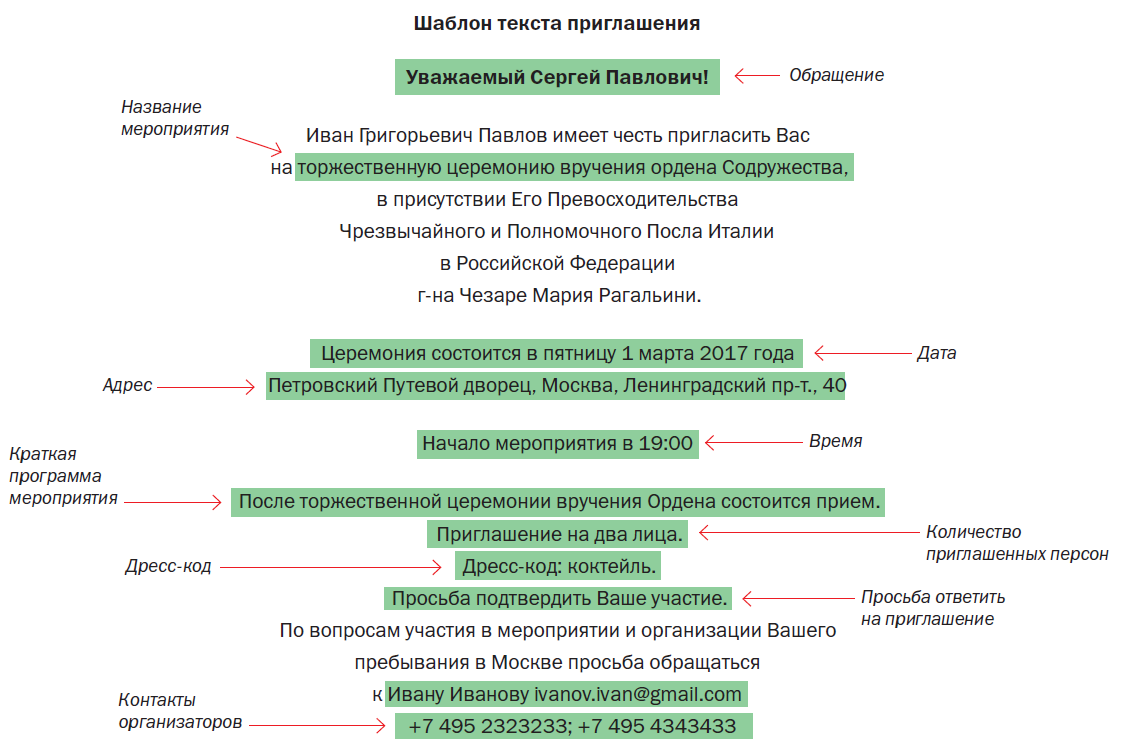
■ Handling. It will not be superfluous to order personalized invitations with the names of the invitees printed in the printing house (entering them in an empty field is not the best option).
Appeal to the guest must be accurate and correct - mistakes are not allowed here. There are generally accepted formulas of politeness and etiquette. For example, if the invitee is a foreigner with an academic degree or a doctor, then addressing him in English will begin with Dear Professor or Dear Dr. If the invitee occupies an official government post, then the appeal should be appropriate: Dear Mr. Minister or Dear Mr. Ambassador.
It is also necessary to pay attention to the fact that the comma after the appeal gives the text an everyday character or emphasizes the restrained business tone. The exclamation point indicates the importance or solemnity of the event. In the case when there is a comma after the address, the further text should be written with lower case, after the exclamation point - capitalized.

All these seemingly insignificant details make the invitation very personal and correct. The invitee will certainly appreciate the attentive and respectful attitude hero of the occasion to his guests.
■ The name of the event. The invitation must contain the full official name activities (no abbreviations).
■ Location, date, time. The date, time and place of the event are indicated according to the rules adopted in the guest's country (if the invitation is in the appropriate language). For example, for an American invitee, these details would look like this: date - March 1? 2017; event start time - 7 p.m.; address - Leningradsky av. 40 Moscow.
■ Event program. In addition to directly addressing the guest, the name of the event, the place and date of its holding, the invitation must necessarily indicate the program of the event (main points), preferably with an indication of the start time of each part. The program can be presented in detail or as a list of the main thematic parts.
A detailed program is especially relevant for top-level official visits. In this case, it can be issued as a separate brochure or card (depending on the number of planned items (Example).
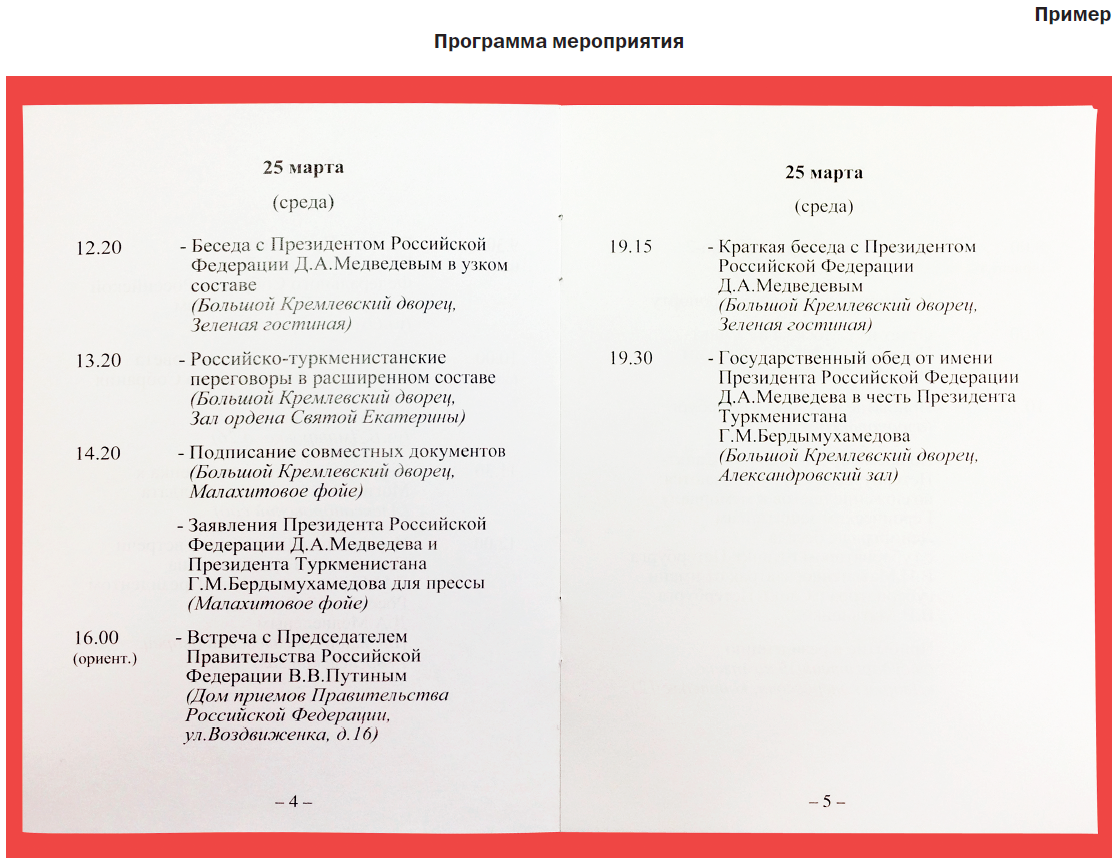
The best option for presenting the program in the invitation might be the following:

The designation of the parts of the program of the event can be very brief, for example: After the official part, a reception will take place.
The format can be different - it all depends on the specifics of the event. The key is to give guests an idea of what's in store for them so they can plan their own time.
■ Number of invitees. The text must also indicate the number of persons to whom the invitation applies.
The number of invitees can also be indicated in circulation, for example, when both spouses are indicated in the invitation: Dear Vladimir Petrovich and Olga Sergeevna or Dear Mr. and Ms. Korolenko, or Mr. Ambassador asks Mr. Petrov and his wife to come to the banquet.
■ Dress code. The dress code in the invitation is at the discretion of the organizer. If there certain requirements to the color or style of clothes of the guests, then this is written in the invitation. For example, Evening Dress for ladies, tuxedo for men.
If the event is official business, the invitation usually indicates the international name of the dress code.
DECRYPTION OF THE BASIC DRESS CODES
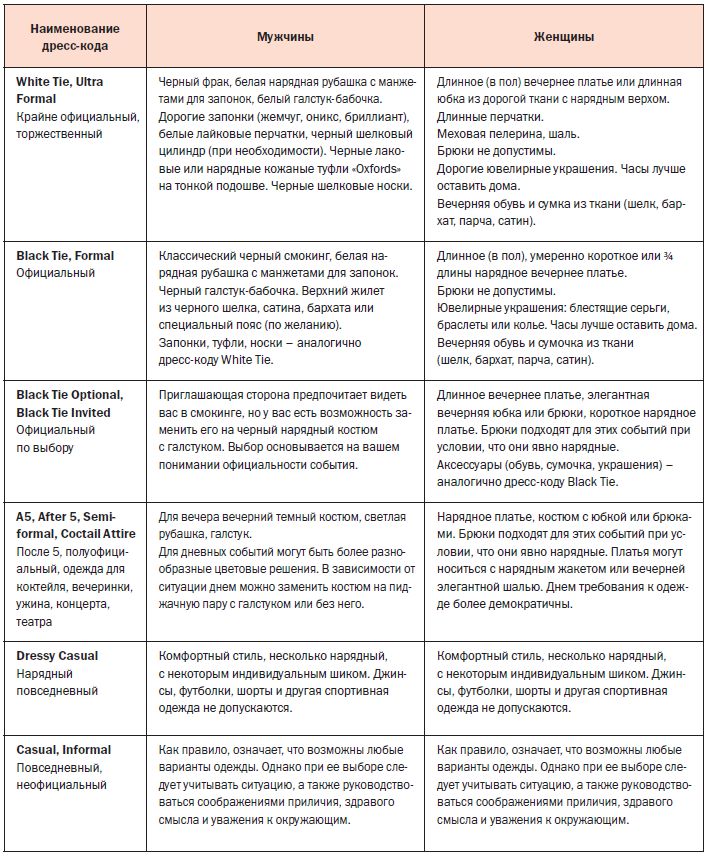
■ Please respond to the invitation. If the event provides seating for guests, it is necessary to find out the exact number of those who will be able to attend.
To focus the attention of the invited person on this moment, the generally accepted abbreviation is put in the invitation RSVP. In formal invitations, RSVP is indicated in the lower right corner, in less formal cases, these letters can be placed anywhere (usually at the end). Sometimes they ask for a response before a specific date.
In addition to RSVP, there are formulations Please answer only in case of refusal or Please confirm your participation, which are also quite official and correct.
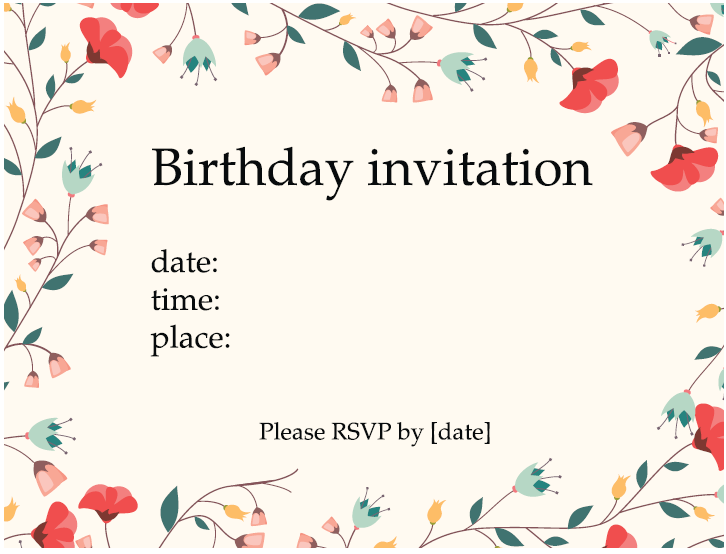
■ Contacts of the organizers. It is important to indicate in the invitation several options for feedback (e-mail and at least two phone numbers of the organizers).

■Additional Information. The invitation may also indicate another necessary information depending on the specifics of the organization and conduct of a particular event (for example, if the event is held in a historic mansion, then wearing stiletto heels may be prohibited) .
■ Banquet seating plan. If, in addition to the official part, a banquet or a dinner party is planned, for especially large-scale and solemn events It is appropriate to include in the invitation a seating plan indicating the table and/or seat of a specific guest.
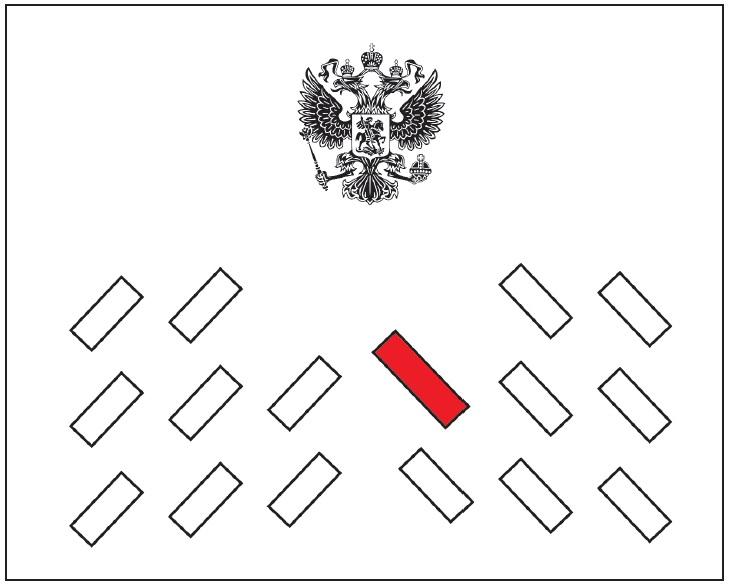
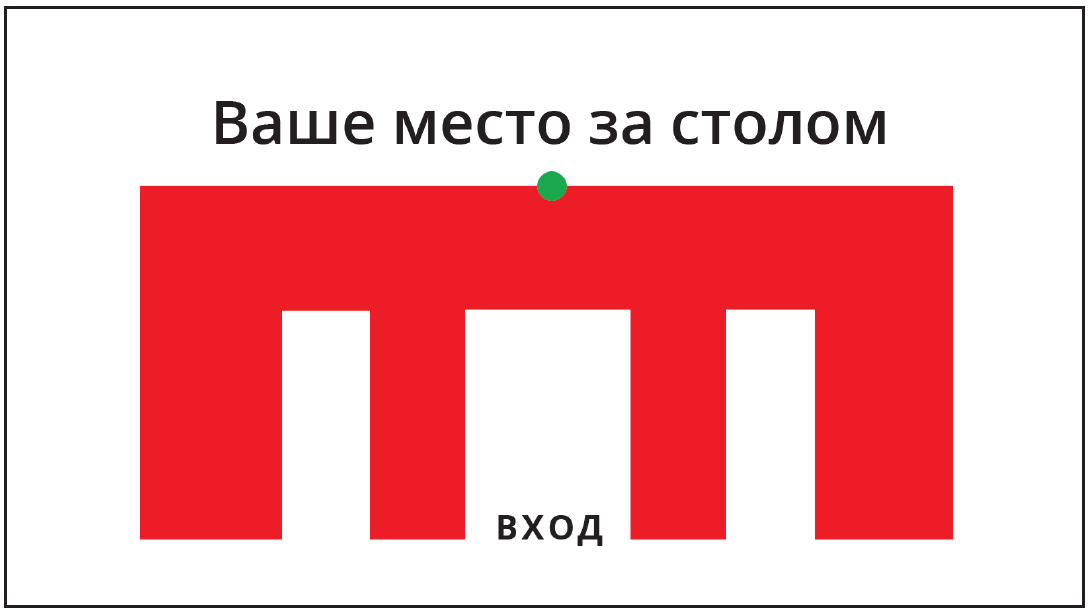
DETERMINING THE DESIGN AND FORMAT OF THE INVITATION
This is the “clothes” by which the invitation is “greeted”.
The size and design of the invitation depends on the purpose and nature of the event.
Invitations to diplomatic receptions and international forums, sent by embassies and members of the government, are issued in strict business style on official forms with the state emblem.
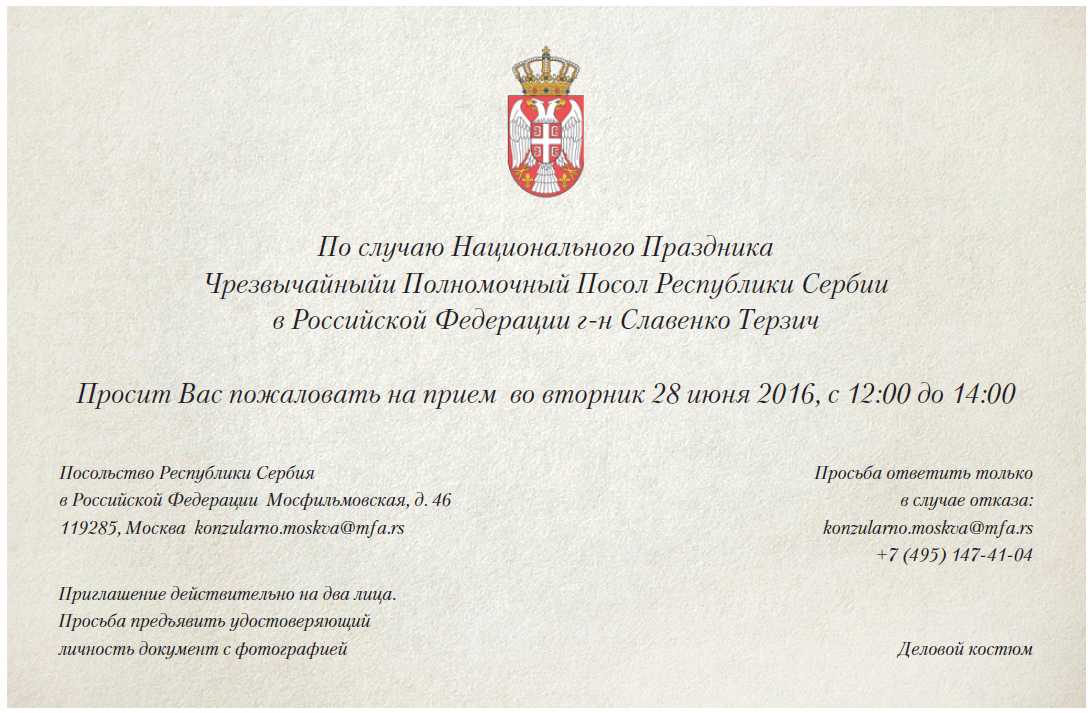
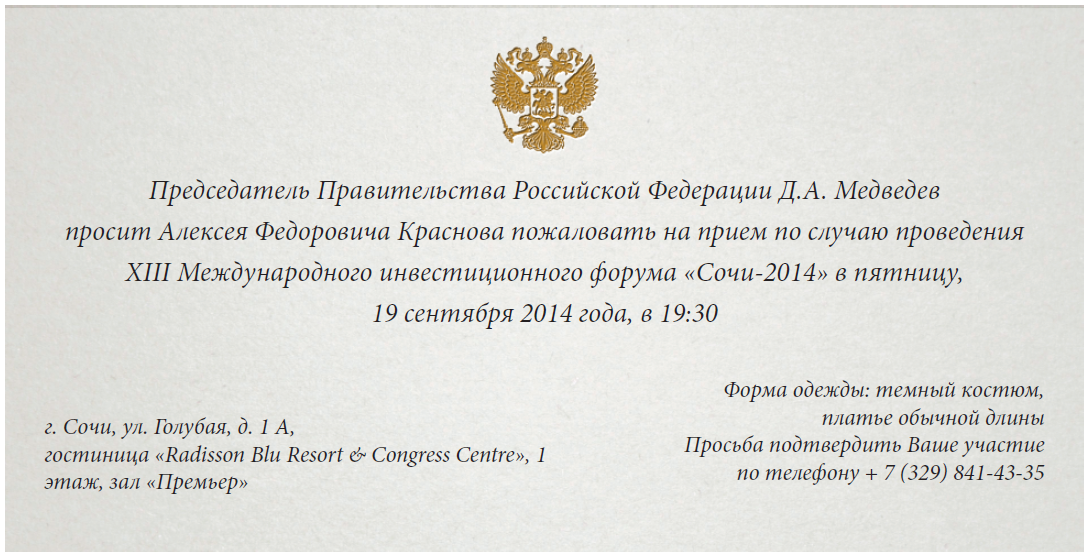
An invitation to an informal reception. Even if the event is not official, the strict style is usually kept.
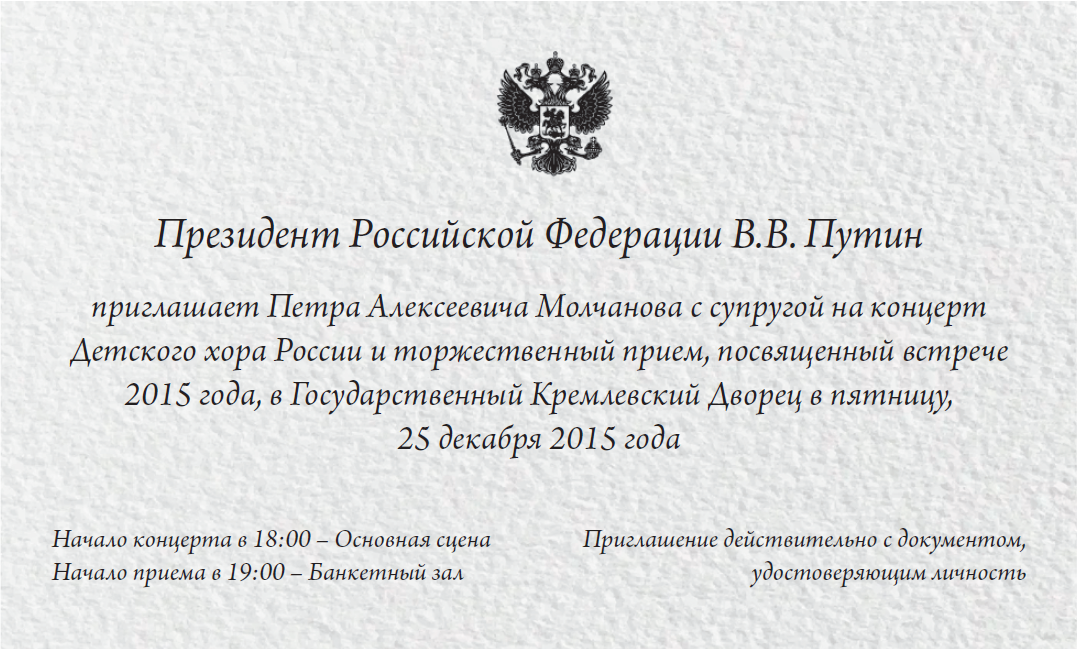
Invitation to an event, the purpose of which is to collect as much as possible more guests , will be bright and catchy.
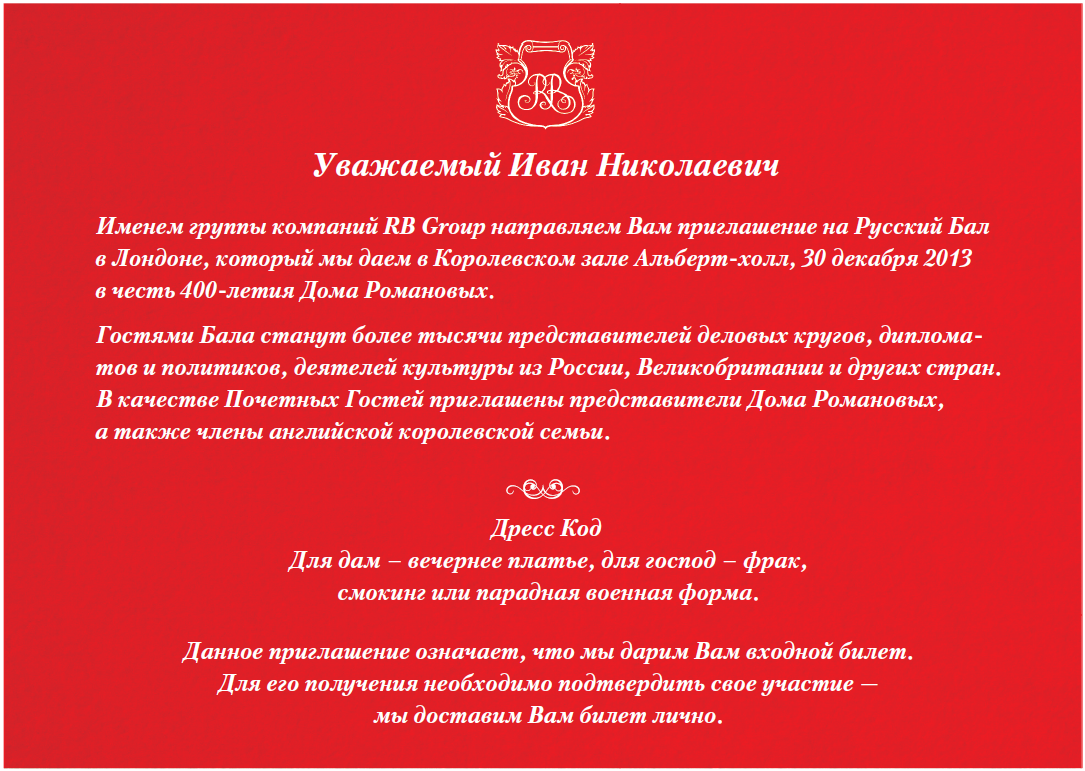
On a personal invitation, for example, wedding, both monograms and hearts, as well as a discreet floral background, are quite appropriate.
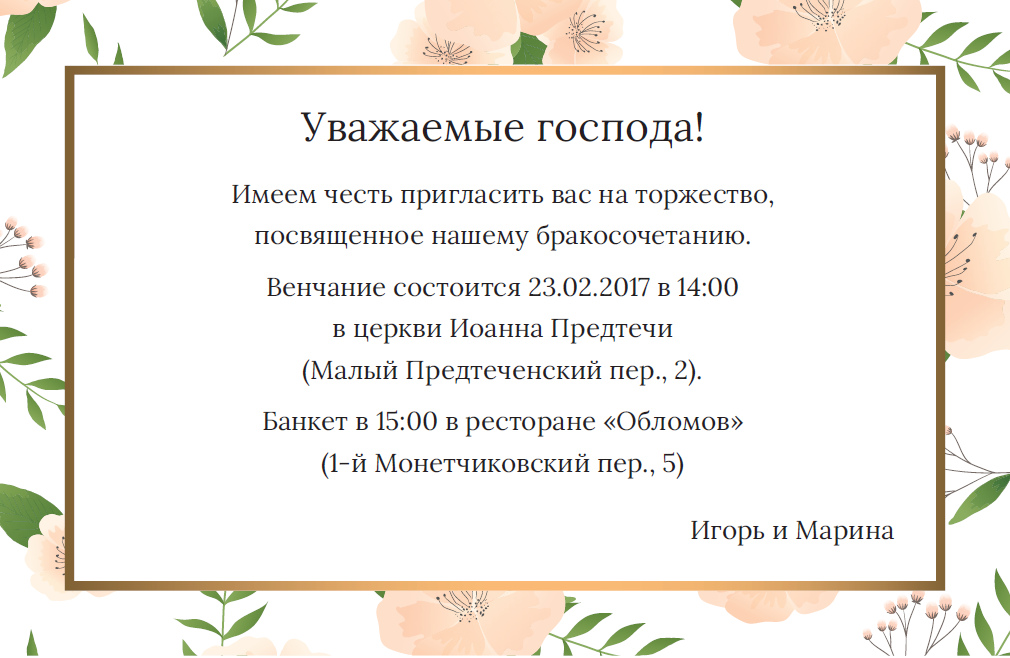
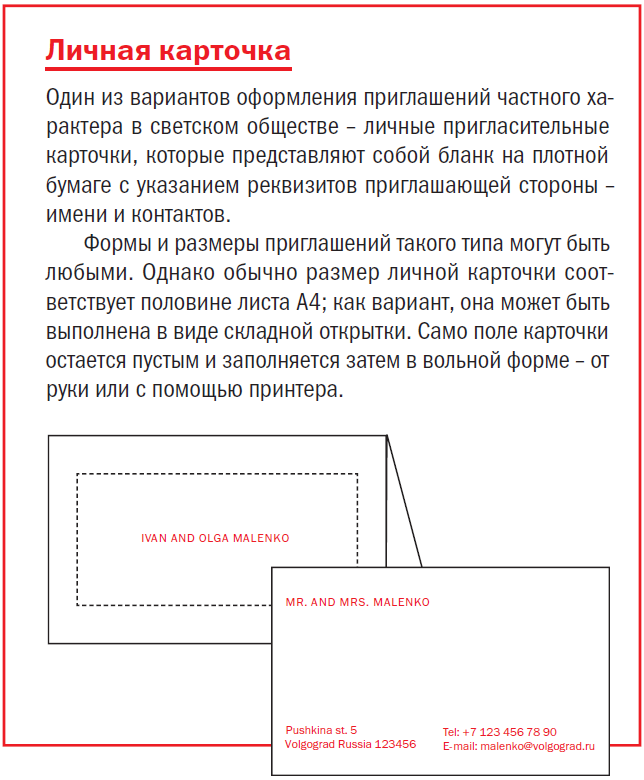
When determining the format of the invitation, you can focus on the size of standard envelopes.
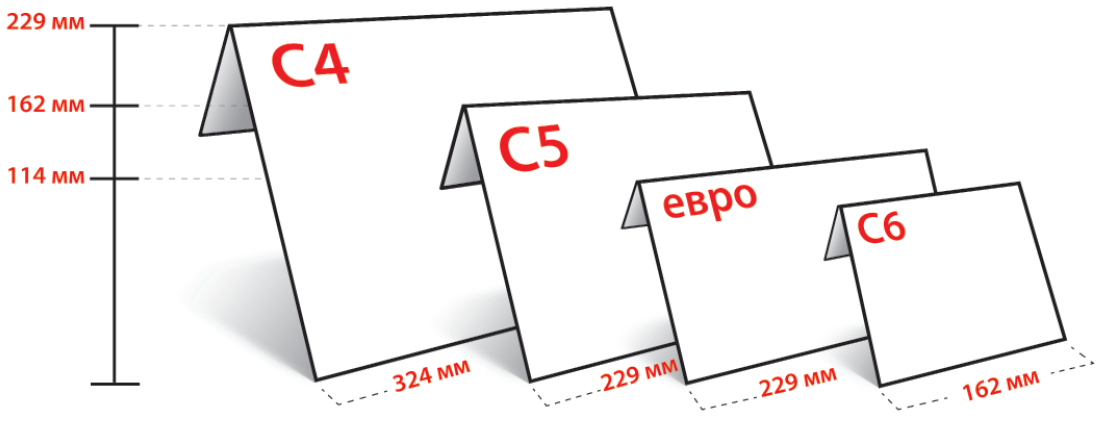
DO NOT FORGET ABOUT PAPER AND PRINT QUALITY
It is not customary to save on the quality of invitations for high-level events. The paper should be the "correct" density and pleasant texture. It is unacceptable that the printing ink is smeared or the text is poorly readable.
It is desirable that invitations be sent in special designer envelopes that are not inferior in quality to the invitations themselves.
Do not forget that the text of the invitation may not be printed on the invitation itself, but on the tab to it. As a rule, on thin, almost transparent paper. Make sure that it, despite its apparent fragility, is still sufficiently resistant to mechanical stress.
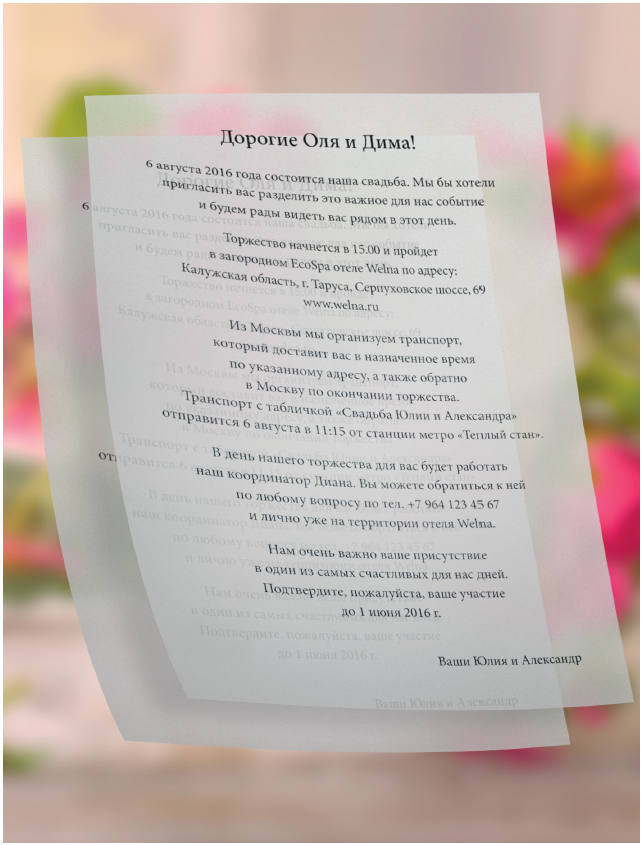
WE DELIVER INVITATIONS
If possible, at least part of the invitations must be delivered, if not personally, then with the help of "your" people - security, drivers or assistants to the hero of the occasion.
Usually, they deliver invitations to especially high-status guests on their own. For example, it would be extremely strange to send an invitation to a high-ranking official through an ordinary courier.
In addition, this will once again express your respect.
In order to know for sure that the invitations have reached the addressees, you need to duplicate the messages by sending them electronically to each guest.
HOW TO RESPOND TO INVITATIONS
The answer to the invitation is given in accordance with the format of the event and the invitation itself.
Quite acceptable in some cases. phone call, in others, an e-mail is enough, and in others, you can not rush to answer at all and wait for the corresponding question from the inviting party (this can be afforded, for example, by high-ranking persons).
However, if the invitation contains the abbreviation RSVP, then it is simply necessary to give an answer, and as soon as possible.
In the case of an official diplomatic reception, acceptance of the invitation or refusal to participate in the event must be in writing in accordance with the business protocol. For example:
M.I. Petrov has the honor to acknowledge receipt of Mr. Ambassador's kind invitation to dinner on Tuesday, March 10 at 20:00, which he gladly accepts.
M.I. Petrov, due to going on vacation, unfortunately, will not be able to accept the kind invitation of Mr. Ambassador for lunch on Tuesday, March 10 this year.
When preparing a private personal event, they usually do without a paper version of invitations - they are limited to electronic ones. In this case, the task for the guest is completely simplified. Usually, electronic invitations provide the opportunity to inform the organizer of the event about your decision with one click - by the word "Accept" or "Reject". The reply is automatically sent to the sender.
Working with invitations is sometimes more difficult than it seems at first glance. However, having successfully coped with this part of the preparation of the event, the organizer can be sure that a significant layer of tasks has already been completed! There is still a lot of work and trouble ahead, but this is more of a routine organizational issues. The difficult process of simultaneous interaction with dozens of invited guests is already behind us. The rest is a matter of technique.
For more information about the organization and holding of ceremonial events, see: Zhemchugova S.A. Award ceremony: how to organize and conduct // Secretary-Referent. 2017. No. 1. P. 4-13.







